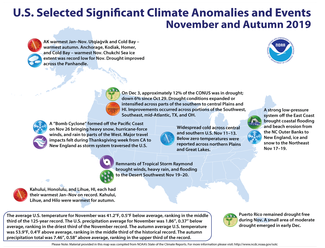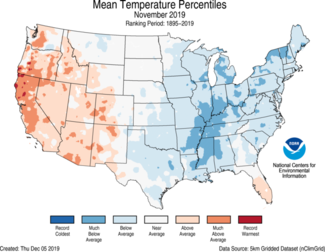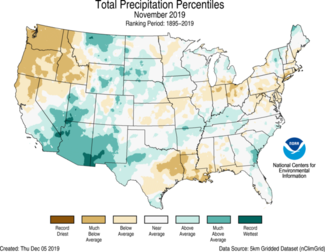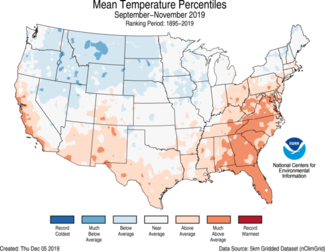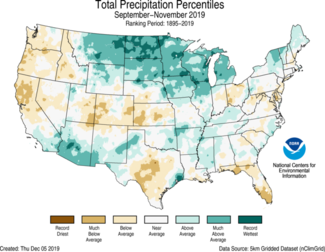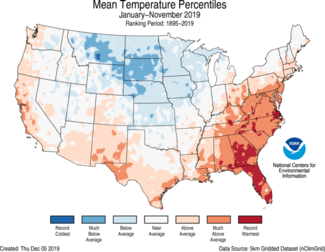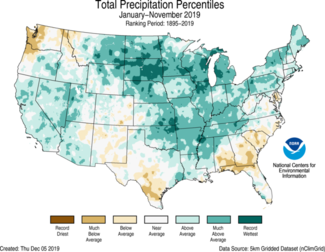
For November, the contiguous U.S. average temperature was 41.2°F, 0.5°F below the 20th century average, ranking in the middle third of the November record. During meteorological autumn (September–November), the average temperature for the Lower 48 was 53.9°F, 0.4°F above average, also ranking in the middle third of the historical record. For the year to date, the contiguous U.S. temperature was 54.2°F, 0.4°F above the 20th century average. This ranked in the middle third of the January–November record.
The November precipitation total for the contiguous U.S. was 1.86 inches, 0.37 inch below average, ranking in the driest third of the 125-year period of record. The autumn precipitation total across the Lower 48 was 7.46 inches, 0.58 inch above average, ranking in the upper third of the historical record. The year-to-date precipitation total across the contiguous U.S. was 32.14 inches, 4.55 inches above the long-term average, ranking as the wettest January–November on record. Average precipitation across the contiguous U.S. for the 12-month period December 2018–November 2019 was 35.39 inches, 5.45 inches above average, exceeding the previous December–November record set in 1982-83 by 0.31 inch.
This monthly summary from NOAA National Centers for Environmental Information is part of the suite of climate services NOAA provides to government, business, academia, and the public to support informed decision-making.
November Temperature
-
Above- to much-above-average November temperatures were observed from the West Coast to the Rockies and across parts of southern Florida. California ranked tenth warmest and eight additional states across the West ranked above average for the month.
-
Below- to much-below-average temperatures were present from the central U.S. to the East Coast. Average temperatures across Michigan, Indiana, Kentucky, Arkansas, Mississippi, and Vermont ranked among the coldest ten percent of Novembers on record.
-
The Alaska average November temperature was 19.9°F, 8.2°F above the long-term mean, ranking fourth warmest in the 95-year period of record for the state. Record warm conditions were observed across the Northwest Gulf and South Panhandle regions. Anchorage, Kodiak, Homer, and Cold Bay experienced their warmest November on record, while Utqiaġvik (Barrow) and King Salmon experienced their second warmest such month. Much of the state had monthly average temperatures well-above average for the month.
November Precipitation
-
Above-average precipitation was observed across the Southwest and parts of the Rockies and Great Plains. Arizona ranked third wettest for November, while New Mexico ranked fifth wettest.
-
A number of new rainfall records were set during November across Cochise, Pinal, Pima, and Graham Counties in southeast Arizona. The remnants of Tropical Storm Raymond and a mid-latitude low-pressure system, which occurred during the last two weeks of the month, were major contributors to these record values.
-
St. George, UT, had a record 155-day streak with no measurable precipitation beginning in mid-June 2019. On November 20, St. George received 1.29 inches of rainfall, making November 2019 the wettest such month on record.
-
-
Below-average precipitation occurred across the Pacific Northwest, Deep South, and parts of the central Plains, Great Lakes, and mid-Atlantic to Northeast states. The states of Washington and Idaho ranked fifth driest, while Oregon ranked seventh driest for November.
-
Between one and three feet of snow fell across portions of eight states the week of Thanksgiving impacting travel from the Rockies to New England.
-
In Alaska, it was the wettest November since 2005 at Ketchikan with 21.27 inches of precipitation reported. Much of the North Slope received record amounts of precipitation during the month. The Panhandle region received above-average precipitation over the last couple of months, which helped to alleviate some of the long-term severe drought conditions across the region.
-
According to the December 3 U.S. Drought Monitor report, approximately 12 percent of the contiguous U.S. was in drought, down 6 percent from the end of October. Drought conditions expanded or intensified across parts of the southern to central Plains, Hawaii and southeastern Puerto Rico, while improvements were seen across the Southwest, Southeast, and parts of Texas, Ohio, and the mid-Atlantic region, as well as in the panhandle of Alaska.
Autumn (September–November) Temperature
-
Above- to much-above-average autumn temperatures spanned from the West Coast to the Southwest and from the Gulf Coast to the mid-Atlantic region. Florida ranked fifth warmest while Georgia and South Carolina ranked sixth and seventh warmest, respectively.
-
Below-average temperatures for autumn were observed across the Northwest to northern Plains and northern parts of New England. Montana and Idaho ranked 17th and 18th coldest on record, respectively.
-
The Alaska statewide average temperature for autumn was 31.7°F, 5.8°F above average and ranking as the fourth warmest such period on record. Record warm temperatures were observed across a large portion of the North Slope as well as the Aleutians and Northwest Gulf regions. Utqiaġvik had its warmest autumn on record with an average temperature of 28.8°F, 2.7°F warmer than the previous warmest autumn, in 2016.
Autumn (September–November) Precipitation
-
Above- to much-above-average precipitation was observed from the northern Plains to the Great Lakes and across parts of the Southwest, Northeast, and mid-Mississippi Valley to Ohio Valley. North Dakota, Minnesota, and Wisconsin each had their wettest autumn on record with Michigan experiencing its second wettest such season on record. South Dakota, Iowa, and Arizona also ranked in the top ten wettest category.
-
Much-below- to below-average precipitation was observed across parts of the West, central Rockies, and central to southern Plains, as well as Florida, where the autumn precipitation ranked as the 13th driest on record.
-
Precipitation during autumn was much-above- to above-average across much of Alaska.
Year-to-date (January–November) Temperature
-
Above- to much-above-average year-to-date temperatures were observed across portions of the West, Southwest, southern Plains, and from the Gulf of Mexico to parts of southern New England. The year-to-date average temperature for both Florida and Georgia ranked as the warmest such period on record while North Carolina, South Carolina, and Virginia ranked second warmest. Six additional Southeast to Mid-Atlantic states had year-to-date temperatures in the top ten warmest category.
-
Below- to much-below-average temperatures were observed across the northern and central Plains and Upper Midwest. South Dakota ranked ninth coldest for this year-to-date period.
-
Year-to-date temperatures ranked record warm across Alaska, eclipsing the warmth of 2016 by a narrow margin.
Year-to-date (January–November) Precipitation
-
Above- to much-above-average January–November precipitation occurred in parts of the West as well as from the northern Rockies to the Gulf Coast and east into New England. North Dakota, South Dakota, Minnesota, Wisconsin, and Michigan ranked wettest on record for this year-to-date period. Sixteen other states ranked in the top ten wettest category.
-
Below-average precipitation occurred across parts of the Southeast, southern Texas, New Mexico, and the coastal Northwest, with Washington state ranking eighth driest.
-
January–November precipitation was wetter than average across much of southwestern Alaska as well as northern and eastern portions of the state. Drier-than-average conditions were present from the central Gulf to the Panhandle.

